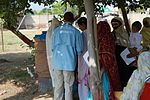COVID-19 triage tent outside of a Swedish Hospital
9/11 triage station outside of the Pentagon
2010 Pakistan floods triage station under a tree
Korean War triage station in modern South Korea
Mass casualty drill at Misawa Air Base
CBRN triage drill at Yokota Air Base
In medicine, triage (/ˈtriːɑːʒ/, /triˈɑːʒ/) is a process by which care providers such as medical professionals and those with first aid knowledge determine the order of priority for providing treatment to injured individuals[1] and/or inform the rationing of limited supplies so that they go to those who can most benefit from it.[2] Triage is usually relied upon when there are more injured individuals than available care providers (known as a mass casualty incident), or when there are more injured individuals than supplies to treat them.[3]
The methodologies of triage vary by institution, locality, and country but have the same universal underlying concepts.[4] In most cases, the triage process places the most injured and most able to be helped as the first priority, with the most terminally injured the last priority (except in the case of reverse triage).[5] Triage systems vary dramatically based on a variety of factors, and can follow specific, measurable metrics, like trauma scoring systems, or can be based on the medical opinion of the provider.[6] Triage is an imperfect practice, and can be largely subjective, especially when based on general opinion rather than a score.[7][8] This is because triage needs to balance multiple and sometimes contradictory objectives simultaneously, most of them being fundamental to personhood: likelihood of death, efficacy of treatment, patients' remaining lifespan, ethics, and religion.
- ^ Cite error: The named reference
Robertson-Steel_2006was invoked but never defined (see the help page). - ^ Muensterer OJ, Gianicolo EA, Paul NW (January 2021). "Rationing and triage of scarce, lifesaving therapy in the context of the COVID-19 pandemic: a cross-sectional, social media-driven, scenario-based online query of societal attitudes". IJS Global Health. 4 (1): e47. doi:10.1097/GH9.0000000000000047. ISSN 2576-3342. S2CID 220847218.
- ^ Cite error: The named reference
Iserson_2007was invoked but never defined (see the help page). - ^ Cite error: The named reference
World Health Organization_2008was invoked but never defined (see the help page). - ^ Cite error: The named reference
van Ruler_2022was invoked but never defined (see the help page). - ^ Cite error: The named reference
Petridou-2008was invoked but never defined (see the help page). - ^ Cite error: The named reference
Xiang-2014was invoked but never defined (see the help page). - ^ Cite error: The named reference
Turégano-Fuentes-2008was invoked but never defined (see the help page).





